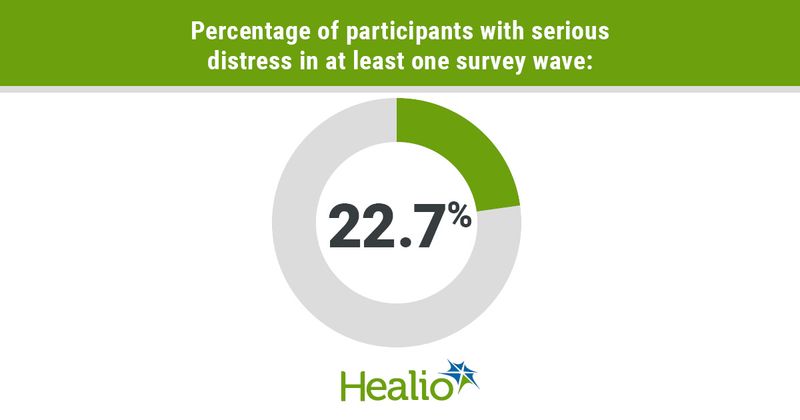US adults’ psychological distress elevated during COVID-19 pandemic
Researchers reported persistent increases in U.S. adults’ psychological distress at four time points from April 2020 to August 2021, according to study results published in JAMA Network Open.
“Whether elevated psychological distress among U.S. adults documented in the early phases of the COVID-19 pandemic has persisted through mid-2021 is unknown,” Emma E. McGinty, PhD, of the department of health policy and management at Johns Hopkins Bloomberg School of Public Health, and colleagues wrote. “We fielded a national survey to assess trends in psychological distress among U.S. adults during four different phases of the COVID-19 pandemic in 2020 and 2021.”

Survey data were collected April 7 to April 13 (wave one), July 7 to July 22 (wave two) and Nov. 11 to Nov. 30 (wave three), 2020, as well as July 26 to Aug. 16, 2021 (wave four). Researchers assessed psychological distress via the validated six-item Kessler Psychological Distress Scale, with a score of 13 or higher on a scale of 0 to 24 representing serious distress. Participants reporting any symptoms of distress answered the question, “During the past 30 days, how often did you see a doctor or other health professional about these feelings?”
McGinty and colleagues included 1,068 adults (48% men; 13% Black; 18% Hispanic; mean age, 49 years) who responded to all four survey waves. A total of 129 (12%) to 157 (15%) participants reported symptoms of serious psychological distress in April, July and November 2020 and July to August 2021. Researchers reported no statistically significant differences in prevalence over time. Participants aged 18 to 29 years, those with a household income of less than $35,000 and Hispanic adults had the highest prevalence of serious distress at all four time points. A total of 242 (22.7%) participants had serious distress in at least one survey wave. Of these, 125 (51.7%) saw a health professional regarding their symptoms. Further, of the 59 (5.5%) participants with serious distress in all four waves, 47 (80%) saw a health professional.
“Although some evidence supports waning distress in May and June 2020 as the first major wave of COVID-19 cases declined, each of our surveys was fielded at a time of increasing case counts in the U.S. overall,” McGinty and colleagues wrote. “More than three-quarters of respondents with sustained serious distress across three to four waves reported accessing treatment, a promising finding given long-standing mental health treatment gaps in the U.S.”

